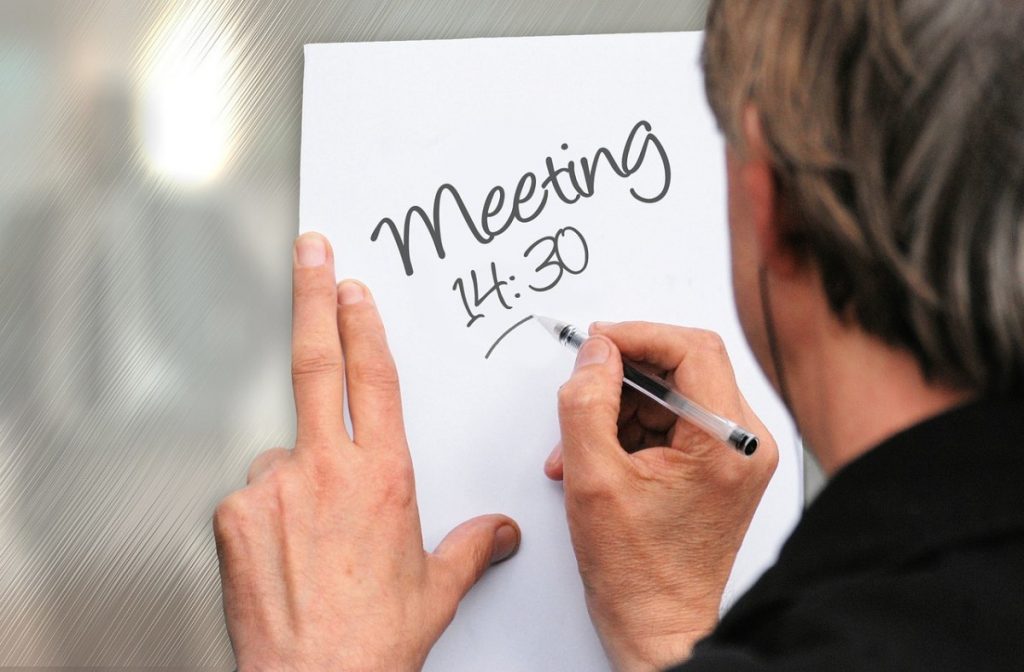Meetings!
The chances are that on any given day, your schedule is chock-full of them.
Just to name a few…
- Strategic planning sessions
- Staff meetings
- Project check-ins
- Status updates
- Brainstorming session
- Periodic goals review
- And even meetings about how to run meetings
These meetings can be very annoying and disruptive to your daily routine. They can also make you feel like your schedule is overflowing with meetings. And it most likely is.
Don’t get me wrong!
Meetings are very important to the growth and well-being of any business. But if meetings consume so much of your time, you should be extracting huge benefits from them, shouldn’t you?
Unfortunately, the reverse seems to be the case.
Understanding how to run effective meetings is one of the most crucial skills employees at all levels need to learn to thrive at work – but it isn’t merely a matter of doing the obvious things like sharing an agenda and starting meetings on time. These things are important; however, they are fundamental.
Most meetings have vague goals, and many usually lack an agenda. Some people walk out of meetings with more questions than answer or even wonder why they attended the meeting in the first place.
People want to do productive things that they feel are truly important – but meetings that lack structures can feel like a colossal waste of time.
The Journal of Organizational Behavior found in a recent study that time-wasting is usually unacceptable in all other aspects of business life, but “in the case of meetings, wasted time seems to be an accepted norm.”
But time is not the only thing that is wasted. According to Fuze, ineffective meetings cost organizations an estimated $37 billion annually.
Organizing and running successful meetings with a human touch is the real key to effective meetings.
But first off, what is an effective meeting?
A lot of times, we interchangeably use the words “effective” and “efficient.”
We think that they both mean the same thing – they don’t, and you must know the difference.
An efficient meeting starts on time, has few people in attendance, sticks to the schedule of the meeting in order to manage time properly, accomplishes its outlined objectives, and ends on time.
Good job, right?
Not really.
You see, as much as it’s excellent to hold efficient meetings, efficiency is more of a superficial quality than anything else. It’s because efficiency doesn’t care that much if the right people attended the meeting for the right reasons; or if the meeting added any real and tangible value to the business.
An effective meeting, on the other hand, combines efficiency and thoughtfulness.
It involves carefully and thoughtfully selecting the right group of people, for the right purpose to deliver tangible results that will add value to the organization.
Here’s an effective step-by-step guide to help running an effective meetings and best practices
1. Is this meeting really necessary?
Some meetings are both essential and necessary, while others are just a complete waste of time.
Things like presentations and status updates often masquerade themselves as essential, but they aren’t that important – these activities can be handled asynchronously via emails, chat, company intranets, etc.
A meeting involves talking WITH teammates, not AT them. Sharing information should never be the sole purpose of holding a meeting, with the notable exception of department and company all-hands meetings. Before scheduling any meeting, the very first thing you need to consider is if the meeting is necessary.
2. Clear purpose for the meeting
For any meeting to be effective, it needs to have a clear, concise, and well-defined purpose, goals, and objectives.
Once you’re sure that a meeting is necessary, the next step will be to create clear, concise, and well-defined purpose, goals, and objectives.
Before you schedule the meeting, ask yourself this: “what are we looking to achieve with this meeting?”. It’s especially true for recurring meetings, as this will help you figure out how frequently these meetings need to be held.
Having clear, concise, and well-defined purpose, goals, and objectives ensure that discussions in the meeting center on essential factors that will lead to the overall growth and well-being of the organization.
3. A meeting agenda
After you’ve clearly defined the purpose, goals, and objectives of the meeting, the next step will be to create the agenda of the meeting.
Yeah, I know!!!
It can be tempting to scribble down some points on any sheet of paper and call it your agenda to get it over with.
However, taking your time to prepare your agenda beforehand can help you get your priorities right and keep discussions on the right track, so you don’t miss out on important points to be discussed.

A meeting is most likely going to be a colossal waste of time if you can’t describe its purpose in actionable and result-oriented terms.
You can begin by writing the topics you want to center your discussion on in the meeting. It can include things like brainstorming new product ideas, analyzing results for the past quarter, and action steps to take moving forward.
To make this even more efficient, designate time-blocks that allocates a certain number of minutes to each of these topics to ensure that no important topic is left out.
In addition to creating an agenda for your meetings is designating facilitators.
The job of facilitators is to keep people on track with the agenda of the meeting. It can mean interrupting someone for speaking longer than necessary, calling out participants for drifting off the topic or summarizing the next action steps to be taken.
4. Meeting attendees
You’ve determined if a meeting is necessary, you’ve clearly defined the purpose, goals, and objectives of the meeting, you’ve created your meeting agenda, now, it’s time to determine who and who should attend the meeting.
You shouldn’t just call a meeting or blast out email invites to everybody that comes to your mind.
Meetings can come with huge costs, both in productivity and in time used, so you need to take the time to carefully and thoughtfully determine those that can make unique and relevant contributions to the meeting. You also need to keep the number of attendees to the barest minimum.
If you’re trying to solve a technology problem — then inviting the marketing team to the meeting is entirely unnecessary; you only need to invite the tech guys.
If you’re making an announcement that affects a few of your staff — then inviting the whole company to the meeting is entirely unnecessary; you only need to invite those that will be affected by such an announcement.
It’s imperative because when people find themselves in meetings where they can’t make any reasonable contribution due to lack of skill or expertise, or that the topics to discuss are irrelevant to them, they’ll see the meeting as a waste of their precious time.
You should also make sure that the invitees of the meeting come with diverse perspectives, especially if it’s a strategic planning meeting or a brainstorming session. It creates more room for creativity to take place.
Unfortunately, there’s no formula to guarantee that you’re balancing the cost of the meeting to the organization with the potential for creativity, and your best judgment is all you can apply.
5. Share the meeting agenda in advance
There are very few things that are as annoying as someone scheduling a meeting and sending out an invite with no indication as to what will be discussed in the meeting — leaving the invitees clueless as to why they are at the meeting in the first place.
Once you’ve determined who should attend the meeting — the next step to take is to share the meeting agenda with them.
Sharing the meeting agenda in advance helps you get straight down to business, as it will give the attendees the time to familiarize themselves with the discussion points. They can also collect any information that will be needed or prepare questions on things that don’t seem clear to them before the meeting.
6. Keep attendees engaged
According to John Medina, a molecular biologist and author of Brain Rules:
“You’ve got 10 minutes with an audience before you will absolutely bore them. And you’ve got 30 seconds before they start asking the question, ‘Am I going to pay attention to you or not?’ The instant you open your mouth, you are on the verge of having your audience check out.”
Using this knowledge — you can engineer your meetings so that in the first 30 seconds of the meeting, you can share the most interesting points of the meeting to arouse the interest of the attendees.
Every ten minutes or so, do or say something that will re-ignite their interest. As much as possible, avoid too much technicality in the discussions as too much technicality tends to deplete most people’s willpower and attention.
Another way of keeping attendees engaged is by preparing them for active listening.
Active listening involves focusing all your attention on the speaker, pay attention to their words, gestures, tone of voice, and even facial expressions, rather than just waiting for your turn to speak.
Some of the ways you can encourage active listening include
- Making the meeting environment comfortable.
- Scheduling the meeting at optimal times of high energy.
- Optimal lighting of the meeting room or venue.
- Getting rid of technological distractions like laptops and phones (we’ll get to that in a moment).
7. Assign a note-taker

You’re probably already familiar with this Mark Twain quote —“A dull pen is better than the sharpest mind.”
Taking notes during meetings is not just a good habit, but a necessary one. It’s because it serves as a written record of your discussions, decisions, and the next action steps to follow. And this will be very helpful for invitees who were unavoidably absent but still need to inform them about the meeting discussions.
Ideally, you need to assign the role of the note-taker to someone before the meeting (typically when you’re sending out meeting invites).
It might also be beneficial to use a note-taking app to make sure that you don’t miss anything. These note-taking apps also make it easier to share the meeting agenda, discussion points, and the action items with all the attendees.
Some note-taking apps also allow you to collaborate in real-time.
Here are a few note-taking apps that you can use
- Evernote
- Microsoft OneNote
- Apple Notes
- Google Keep
- Notion
- Boostnote
- Milanote
- Simplenote
- Standard Notes
8. Get rid of technological distractions
The same electronic gadgets we carry around these days that help make our lives easier and also have the ability to make us more productive at work — are also the biggest and most dangerous distractions that we have today.
Unless you’re the scribe (or note-taker) — your electronic gadgets should be silenced and put out of sight to reduce distraction and enable both you and those around you to concentrate.
“But I can concentrate on the meeting while checking my social media or by email,” some might argue.
Yeah, right. I call BS on that!
We’re all aware of how addictive these tech gadgets and their applications can be. It’s almost impossible for someone to be going through their phone and still focus on the meeting.
One minute you’re checking your email for any important email that you might have received, the next minute, you’re either playing Candy Crush or scrolling through your infinite Facebook NewsFeed.
An Extra Tip — You can actually make the scribe take note the old-fashioned way — with a paper and a pen, or on a whiteboard, rather than with a laptop.
There’s the tendency of the scribe getting distracted by pop-ups and notifications on the device. Also, whoever is sitting beside the scribe will most definitely get distracted by the screen or the sound of typing.
At the end of the meeting, the scribe can then take photos of the notes and share it with everyone, including those that were unavoidably absent.
9. Start early and end on time
Starting and ending your meetings on time not only builds your integrity as a trust-worthy timekeeper. It shows that you respect other people’s time, and it also saves the company from lost productivity.
When you schedule a meeting at a certain time — you have to begin the meeting with those who are present and let anyone that’s late stand till the end of the meeting.
10. Be result-oriented
Now you’ve set the meeting in motion.
But it’s very easy to drift off-topic and bring up irrelevant topics. You have to be mindful of drifting off-topic for too long or going too deep into technicalities. How long “too long” is, and how deep “too deep” is, is up to the facilitator to decide).
If you have to make a decision — you need to press the team harder to make a decision or recommendation so that action steps can be set and taken at the end of the meeting, rather than let them off the hook with a “maybe,” or a vague decision.
And it’s okay if the whole team is not in full agreement with the decision.
11. Make the meeting more inclusive
Some people are born with more extroverted traits in them, while others are more shy and introverted.
Those with extroverted tendencies might seem to out-talk everyone because they have a natural inclination of (over-)expressing themselves, while those that are introverted rarely speak up unless called upon to do so.
There also is the problem of senior managers taking the helm and coming up with ideas and contributing to a meeting.
In contrast, the junior employees sit around watching the conversation and refraining from making any contribution to avoid being reprimanded (or to avoid feeling inept).
For this reason, you need to make your meetings more inclusive. However, it doesn’t mean that you invite everyone to every meeting in the company (see number 4).
Inclusivity is more of a mindset than anything else.
It involves creating a safe space where others can freely express their thoughts, ideas and opinions without the fear of judgment or being looked down upon — a place where a person’s view is more important than their title.
If you happen to notice one person unnecessarily dominating the discussions of the meeting and talking more than his or her fair share, call that person out. And do so publicly so that others will know that you care about their opinions too.
You can say something like: “We appreciate your opinions and contributions, we do, but we need to hear other people’s opinions too so that we can make the most informed decision.”
Another way you can tackle such a situation is to hand over the responsibility of taking notes to anybody that tries to dominate the meeting. It transitions them from talking mode to listening mode and gives others a chance to speak.
12. Decide and assign the next steps

Your next job is to assign the action steps that need to be taken after the meeting.
To do this, you need to:
- First of all, summarize the meeting and the decisions made.
- Make a list of action steps to be taken.
- Assign these action steps with a deadline to specific individuals or teams when possible. It will keep the teammates accountable and make expectations clear.
13. Follow-up
Assigning the next action steps to be taken, with the deadline is not enough.
You have to regularly track these action items to make sure that some progress is being made.
Here are some extra tips that can help you run productive meetings
- Fix the time of the meeting at odd numbers. For example, you can schedule a meeting for 8:47 am instead of the regular 9:00 am or 9:30 am. It will help the attendees remember the time of the meeting.
- Try holding the meeting in an unusual (but safe) environment like a local coffee shop, a basketball court, etc.
- Try holding stand-up meetings. These are short meetings of maybe 10 minutes, where everyone stands until the end of the session. It’s a prevalent practice commonly known as daily scrums — now widely used by developers, project managers, and marketers.
- Keep your meetings as brief as possible. Don’t set up a meeting to last longer than an hour (that’s the maximum amount of time that produces productive discussions).
- To ensure that everyone gets a chance to speak at the meeting, invent some type of a “talking stick” in the form of a small token like a poker chip or a weirdly-shaped object that is passed randomly to a person to speak. When that person is done sharing their ideas and opinions, they give the “talking stick” to someone else who is yet to receive the “talking stick.” The only person that’s permitted to speak without the “talking stick” is the facilitator of the meeting, and it should only be when they’re carrying out their jobs as facilitators and not when they are contributing their ideas and opinions.
- Make arrangements for refreshments — tea, coffee, or glucose-based drinks to boost concentration and willpower (which is necessary for optimal decision making) during your meetings. It’s because the more you concentrate, the more you deplete your willpower, which is a finite resource. There are two components that determine the amount of willpower you have at any given time – the amount of sleep you’ve had and the concentration of glucose in your bloodstream.
Conclusion
Running effective and productive meetings can feel very daunting.
To summarize — hold a meeting only when necessary. Clearly define the purpose and objective of the meeting. Carefully select only those individuals who should attend. Create and share your meeting agenda with them.
During the meeting, be inclusive, and assign the next action steps to be taken after the meeting.
Using all the tips I have outlined here — you can run effective meetings that will have everyone feeling inspired rather than frustrated.
About The Author:



